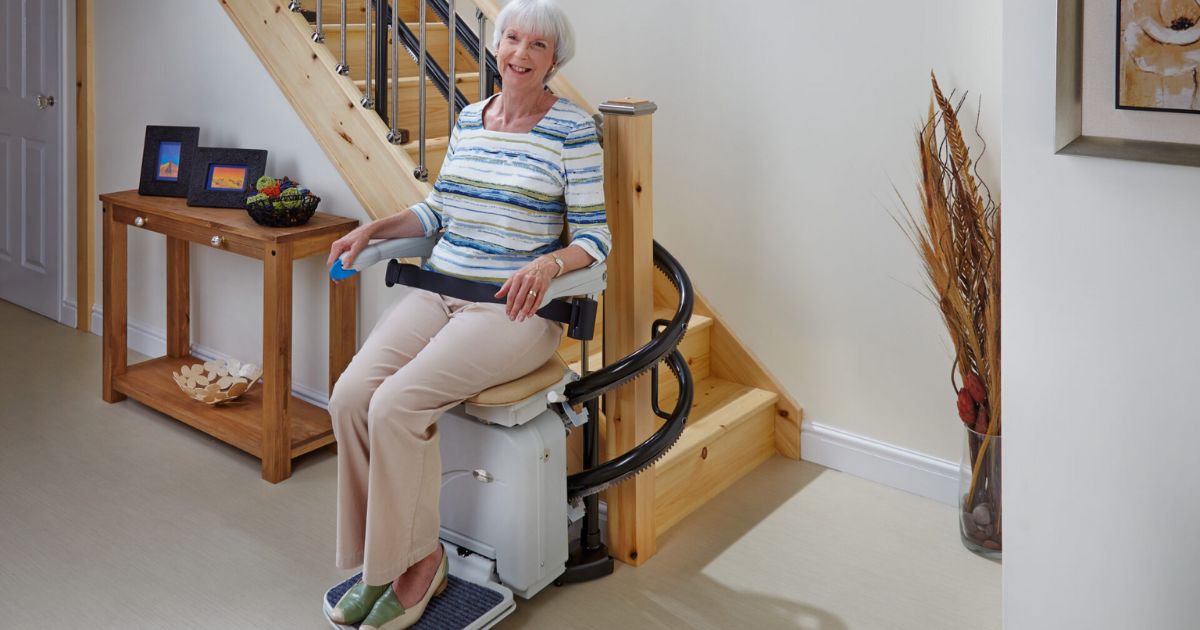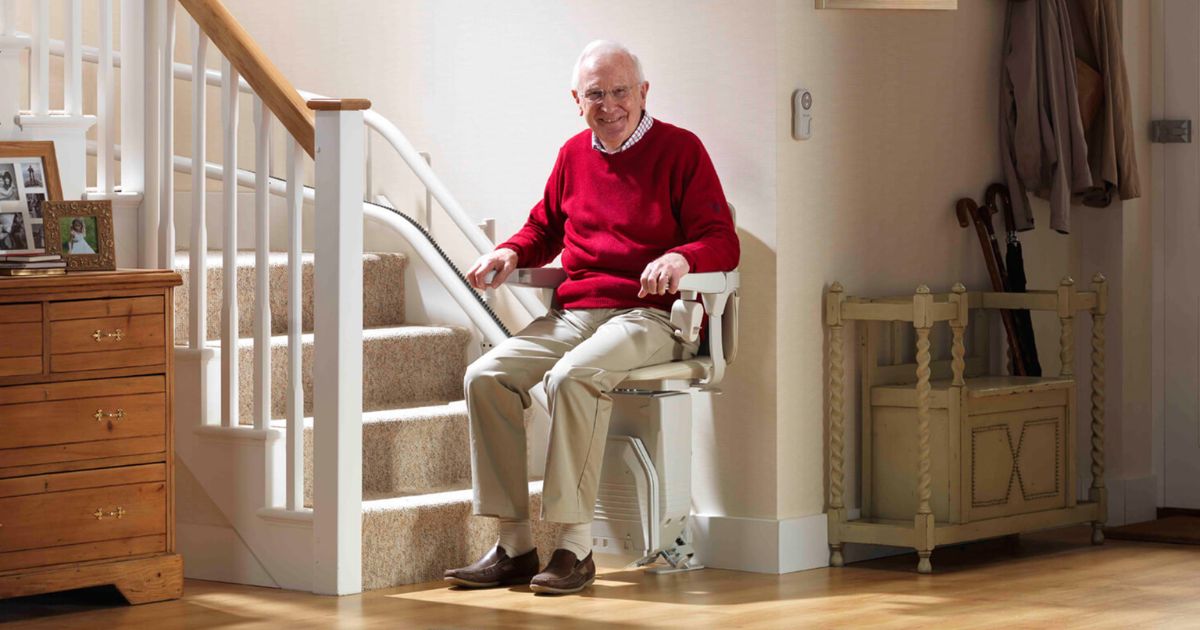Imagine being able to effortlessly glide up and down the stairs, reclaiming your independence and freedom within your own home. For many individuals, a chair lift for stairs provides exactly that opportunity. However, the question remains: does Medicare cover the cost of this essential device?
In this informative article, we will delve into the intricacies of Medicare’s policy on stair lifts, explore alternative financial assistance options, and equip you with the knowledge you need to make informed decisions about your mobility needs.
Key Takeaways
- Medicare does not typically cover the cost of stair lifts.
- Stair lifts are considered home modifications, not durable medical equipment.
- Alternative funding options such as Medicaid, Veterans Affairs benefits, or private insurance may be available.
- Average stair lift costs range from $2,500 to $5,000 for basic straight stair lifts and $8,000 to $15,000 or more for curved stair lifts.
What Is a Stair Lift
In order to understand the potential coverage of a chair lift for stairs by Medicare, it is essential to first grasp the concept of what a stair lift is. A stair lift, also known as a chair lift for stairs, is a mechanical device that is designed to transport individuals up and down a flight of stairs. It consists of a chair or platform that is attached to a rail system, which is then mounted onto the staircase.
The user simply sits on the chair or platform, and with the push of a button, it glides smoothly along the rail, allowing for a safe and convenient way to traverse the stairs. Stair lifts are typically used by individuals with mobility issues or disabilities that make it difficult for them to climb stairs independently.
These devices can greatly improve the quality of life for individuals who would otherwise struggle with stairs, allowing them to maintain their independence and access different levels of their homes with ease.
Does Medicare Cover Stair Lifts

Medicare does not typically cover the cost of stair lifts, as they are considered to be home modifications rather than durable medical equipment. Stair lifts, such as Stair Lifts Covered by Medicare, are devices designed to assist individuals with mobility issues in navigating stairs safely and independently. While they can greatly improve the quality of life for those with limited mobility, Medicare’s coverage policy does not extend to these devices.
Medicare’s coverage is primarily focused on medical equipment and services that are deemed medically necessary. Stair lifts are viewed as home modifications, similar to ramps or widened doorways, which are not typically covered by Medicare.
It is important to note that coverage policies can vary depending on the specific Medicare plan or supplemental insurance coverage. Individuals who require a stair lift may need to explore alternative funding options such as Medicaid, Veterans Affairs benefits, or private insurance.
Some states offer assistance programs or grants that can help offset the cost. It’s advisable to consult with healthcare professionals and insurance providers to explore all available options to make an informed decision.
Average Stair Lift Costs
The cost of a stair lift can vary depending on factors such as the type of lift, installation requirements, and any additional features or customization needed. On average, a basic straight stair lift can range from $2,500 to $5,000, including installation.
If your stairs have curved or multiple landings, the price can increase significantly. Curved stair lifts can cost anywhere from $8,000 to $15,000, or even more depending on the complexity of the staircase. Certain features such as swivel seats, folding arms, and remote controls can add to the overall cost.
It’s important to consider these factors when budgeting for a stair lift, as they can significantly impact the total cost. Consulting with a professional installer or getting multiple quotes can help you determine the specific costs for your situation.
How to Find Stair Lift Discounts
Where can one find stair lift discounts? Finding discounts on stair lifts can help make this essential mobility equipment more affordable. Here are some ways to find stair lift discounts:
- Check with manufacturers: Some stair lift manufacturers offer promotional discounts or special pricing on their products.
- Explore local dealerships: Local dealerships may have special offers or discounts available, especially during specific times of the year or sales events.
- Research online: Websites that specialize in mobility aids or home medical equipment often have discounted prices or sales on stair lifts.
- Inquire about insurance coverage: Some insurance providers may cover a portion of the cost of a stair lift, so it’s worth checking with them to see if you qualify.
Finding stair lift discounts can help alleviate the financial burden of purchasing one. Now, let’s explore Medicare’s policy on covering stair lifts.
Medicare’s Policy on Stair Lifts

Medicare’s policy regarding stair lifts is an important consideration for individuals seeking financial assistance for this mobility equipment. Currently, Medicare does not cover the cost of stair lifts. Medicare considers stair lifts to be “home modifications” rather than durable medical equipment, which is typically covered under the program.
According to Medicare guidelines, home modifications, such as getting wrinkles out of chair covers, are not eligible for coverage, even if they are prescribed by a healthcare professional. This means that individuals who rely on Medicare for their healthcare coverage will need to explore other options for financing a stair lift. It is important to note that some state Medicaid programs may provide coverage for stair lifts, but eligibility criteria and coverage details vary by state.
There are other sources of financial assistance, such as nonprofit organizations and veterans’ benefits, that individuals can explore to help offset the cost of a stair lift.
Medicaid Coverage
Medicaid, a government-funded healthcare program for low-income individuals, provides coverage for certain medical equipment and services, including chair lifts for stairs, in some states. While coverage for chair lifts varies by state, Medicaid generally considers these devices as durable medical equipment (DME).
This means that if you qualify for Medicaid and have a medical need for a chair lift, you may be eligible for coverage.
It is important to note that each state has its own specific guidelines and requirements for Medicaid coverage, so it is essential to check with your state’s Medicaid program to determine if chair lifts for stairs are covered. Keep in mind that Medicaid coverage can change, so it is advisable to stay updated with the latest information from your state’s Medicaid program.
- Some states provide full coverage for chair lifts for stairs through Medicaid.
- Other states may cover chair lifts for stairs partially or under certain conditions.
Assistance for Veterans
Many programs and resources are available to provide assistance for veterans in obtaining a chair lift for stairs. The Department of Veterans Affairs (VA) offers various benefits and services to support veterans’ needs, including home modifications.
Veterans may be eligible for the Specially Adapted Housing (SAH) grant, which provides financial assistance for home modifications, including the installation of a chair lift. The SAH grant is designed to help veterans with severe disabilities live more independently in their homes.
Nonprofit organizations like the Gary Sinise Foundation and Homes For Our Troops also provide support to veterans by constructing specially adapted homes that may include chair lifts for stairs. These organizations aim to improve the quality of life for veterans and ensure they have access to the necessary assistive devices. Veterans can explore these resources to find the assistance they need in obtaining a chair lift for stairs.
State-Based Home Modification Programs
Various states offer home modification programs to assist individuals in obtaining a chair lift for stairs. These programs aim to improve accessibility and independence for individuals with mobility challenges. Here are two sub-lists highlighting the benefits of state-based home modification programs:
- Financial assistance:
- Grants: Some states provide grants to cover the cost of installing a chair lift for stairs.
- Low-interest loans: Individuals can access low-interest loans to help finance the purchase and installation of a chair lift.
- Eligibility criteria:
- Income-based: Some programs consider the applicant’s income level to determine eligibility.
- Disability-based: Certain programs prioritize individuals with disabilities or seniors with mobility issues.
State-based home modification programs offer a lifeline to individuals seeking assistance with obtaining a chair lift for stairs. However, these programs may have specific eligibility requirements and limited funding, making it crucial to explore other financial assistance and payment options.
Other Financial Assistance and Payment Options

In addition to state-based home modification programs, individuals seeking financial assistance for a chair lift for stairs can explore alternative funding sources and payment options. There are several options available to help cover the cost of a chair lift, especially for those who may not qualify for Medicare coverage.
One option is to seek financial assistance from nonprofit organizations and charities that provide grants or low-interest loans for home modifications.
These organizations often have specific eligibility criteria, so it is important to research and apply accordingly. Another option is to consider private health insurance plans that may offer coverage for home modifications, including chair lifts.
Some manufacturers and dealers of chair lifts offer financing options, allowing individuals to spread the cost of a chair lift over a period of time. Exploring these alternative funding sources and payment options can help individuals find the financial assistance they need to make their homes more accessible.
Frequently Asked Questions
Are There Any Tax Incentives Available for Installing a Stair Lift?
Tax incentives may be available for installing a stair lift, although the specific incentives and eligibility criteria can vary. It is advisable to consult with a tax professional or research the relevant tax laws and regulations to determine the options available.
Can a Stair Lift Be Installed on Outdoor Stairs?
Yes, a stair lift can be installed on outdoor stairs, providing an efficient and safe solution for individuals with mobility issues. It allows them to navigate outdoor stairs independently, promoting a sense of belonging and inclusion.
Is It Possible to Rent a Stair Lift Instead of Purchasing One?
It is possible to rent a stair lift instead of purchasing one. Renting a stair lift can be a cost-effective solution for individuals who only need it for a short period of time or prefer not to make a long-term investment.
Are There Any Weight Restrictions for Using a Stair Lift?
Weight restrictions for using a stair lift vary depending on the specific model and manufacturer. It is important to consult the product manual or contact the manufacturer to determine the weight limit and ensure safe usage.
How Often Does a Stair Lift Need to Be Serviced or Maintained?
Stair lifts typically require regular servicing and maintenance to ensure their proper functioning and safety. It is recommended to have them serviced at least once a year, but the frequency may vary depending on usage and manufacturer’s guidelines.
Conclusion
In conclusion, while Medicare does not typically cover the cost of a stair lift for stairs, there are other financial assistance options available. Medicaid may provide coverage for those who qualify, and veterans may be eligible for assistance through the Veterans Affairs program.
Some states offer home modification programs that can help with the cost of a stair lift. It is important to explore these alternatives and seek out discounts or payment options to make stair lifts more affordable. As the saying goes, “Where there’s a will, there’s a way.”








